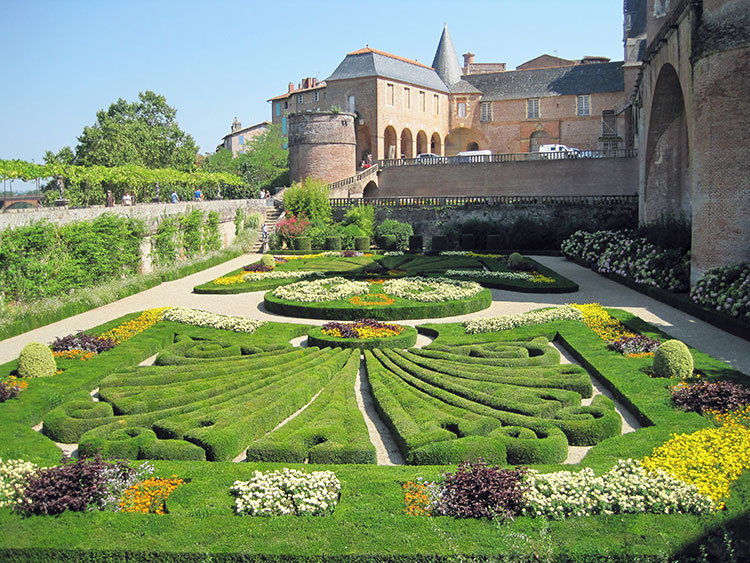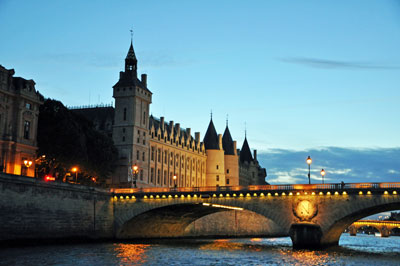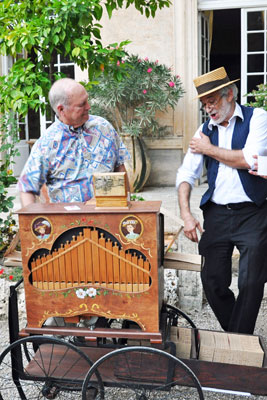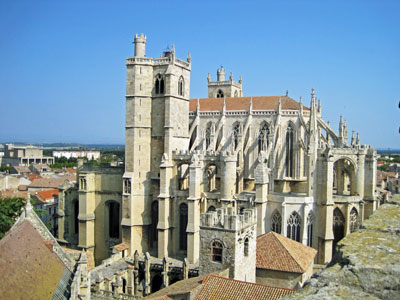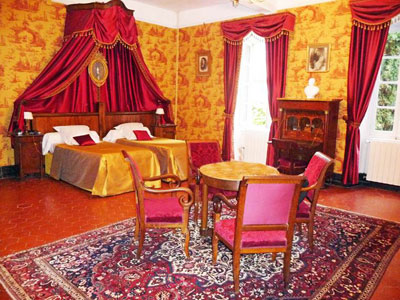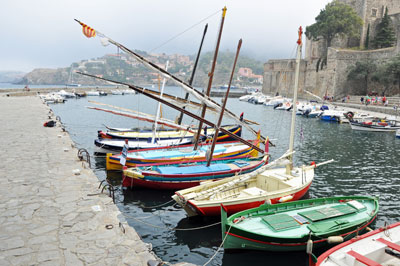Loving life in a château in Languedoc
by Margie Weathers; Hayesville, NC
Back home now, I find myself wishing I were still in the southwest of France in lovely Languedoc. I miss the tree-lined country lanes, the tiny flower-strewn villages, the vast fields of olive groves and vineyards, the food, the wine and, best of all, living in the 12th-century Château d’Agel.
Our Aug. 29-Sept. 15, 2012, trip was prompted by nostalgia for the long drives through France my husband, Cliff, and I used to make when he was in the US Army and we were making our way from rainy Germany to sunny Spain.
I wanted to see it all again. With independent travel no longer an option for us, we were delighted to find a way to revisit the south of France by booking a 2-week small-group tour titled “Catch the Wind” with Ihla Crowley’s company, Drifter Sister (Boulder City, NV; 702/294-4365). And the 3-day pre-trip to Paris was too good to pass up.
The City of Light
Ihla arranged a stay at a charming, small hotel in Paris’ Latin Quarter, Hotel Minerve, which was convenient to many cafés and restaurants as well as to popular sites such as Notre Dame Cathedral and the Luxembourg Gardens.
On arrival, we each got a packet with museum passes, Métro and hop-on/hop-off bus tickets, city maps and information on Paris’ most popular attractions.
During the all-too-short visit, the nine travelers in our group each had the choice to either go off on their own or stay together. We usually met up for lunch. (Two meals each day were included.)
The hop-on/hop-off buses offered an overview of the city for first-time visitors, and, with many favorite spots clustered together, we could follow our own interests within a small area. Since Cliff and I had been to Paris before, we concentrated on the Rodin Museum and its garden and Les Invalides, a complex of museums and monuments that includes Napoleon’s tomb. We also enjoyed strolling around the Latin Quarter.
Two highlights of our Paris stay were a wine-tasting dinner with scrumptious food and several wines expertly paired to the menu, and a twilight ride down the Seine from the Eiffel Tower with return by the light of a full moon. Pure magic!
On to Narbonne
On Saturday morning, three taxis took the nine of us to the Gare de Lyon railway station for our TGV train to the south of France. Four and a half hours later we arrived in Narbonne, the city where the Romans established their first significant colony outside Italy.
There we met Ihla’s friend Bonnie, who came to drive the rental van to the hamlet of Agel, our home for the next two weeks.
Bonnie and her husband live in Agel part of the year, returning to the US in the winter. She is a real Francophile, speaks fluent French and has immersed herself in the history and culture of the Languedoc region. She served as our guide and translator on our travels to the surrounding area.
The Château d’Agel sits at the highest elevation of this little rural town, with the surrounding houses clustered below. Down a narrow, cobblestoned lane, a huge wooden door opens to a courtyard. Our jaws dropped as we walked inside and saw the towering stone structure with its imposing gardens and adjacent orangerie.
The bedrooms were enormous, as were the bathrooms. The carpets, wall hangings and furniture were elegant and were, as we later learned, the château’s original Louis XIV period furnishings.
One night at dinner, the château’s owners told us about their manor house. We sat in the library with its huge fireplace and shelves lined with leather-bound volumes, amid objects that had been in place for many decades, and sipped wine as we listened.
Built in the 1100s, the château was partially destroyed by fire and rebuilt in the 12th century; the west tower is the only original part. The property came into the current owner’s family (her grandmother was a countess) in the 1700s.
Once modernized with electricity, plumbing, washer and dryer, a well-equipped 21st-century kitchen and even WiFi, the château was made available for lease.
It was intriguing to lie in bed at night in the quiet of the countryside and imagine all that had gone on there through the centuries.
Life in the château
Our daily routine was to fix breakfast in the kitchen from the cheese, bread, fruit, ham, eggs, cereal and incomparable French bread, all furnished by Ihla, who went out of her way to take into account our individual preferences and needs.
After eating, we’d pile into the van and car to see nearby fascinating towns and learn something of their importance to France’s history. The day’s activities were geared toward drives of not more than two hours each.
Wonderful long lunches at small cafés and restaurants put us right in there with the locals. Being near the ocean, seafood was usually a choice, along with the typical regional dish of duck and white bean casserole.
The plat du jour, the 3-course menu, was always more than enough. The presentations were exquisite and the desserts, marvelous.
The day after our arrival, we drove to a farmhouse for a home-cooked Sunday meal that lasted all afternoon. Prominent in the area’s olive-growing cooperative, the young woman who owns the farmhouse is introducing farmhouse B&B stays to the area.
After a day on the road, our evenings in the courtyard, with a small meal of our choosing put together in the kitchen, were restful and pleasant and a good way to get acquainted with other group members.
A special event coincided with our stay in Agel. A traveling troupe of three performers visited the village, and Ihla invited them to use the château’s orangerie (winter greenhouse) for their show. We didn’t understand a word they said or sang, nor could we join the villagers in the sing-along, but we relished the good food at the potluck, and several of us took a turn playing the barrel organ out in the courtyard. We found the townspeople friendly and hospitable.
Early in our stay we toured an organic olive farm, d’Omaine Olea, where our guide was owner Gerard Matet. He educated us about the different kinds of olives — some for eating, some for turning into oil and some good for both — before we went back to his house to taste both olives and oil.
Vineyards were everywhere in this area, with wine making a mainstay of the economy. A tour of a small operation was in order, and we learned the fine points of tasting and selecting wines.
Roman remembrances
Narbonne, a bustling city, was the perfect place to start our adventure. During Roman times, emperor Augustus, wary of large numbers of retired soldiers milling around in Italy, gave them grants of land in the provinces. The legionnaires were happy, Rome was safer, and the agricultural plenty of Gaul benefited the empire. The colonizers brought with them Rome’s genius for organization, management and engineering, which resulted in a time of peace and prosperity.
In the center of the oldest part of town, a large square of the ancient road from Italy to Spain, the Via Domitia, sits exposed, some eight feet below today’s surface.
There is an excellent museum in the city with an underground warehouse complex, called the Horreum, the only one of its kind ever found in the region. Winding down several lanes, the dark passageway was lined with small storerooms.
The Cathars
Several of the cities we toured — Albi, Carcassonne, Cucugnan and Minerve — figured prominently in the 13th-century persecution of a religious body that came to be regarded as a threat to the power of the Roman Catholic Church.
Their name taken from a Greek word meaning “pure,” the Cathars aspired to purity and perfection. A nonviolent, vegetarian, progressive people, they were denounced as heretics by the Church. They were, however, beloved by the people, who were disgusted by the excesses and corruption of the clergy and gave the Cathars shelter.
The king of France made common cause with the Church in its pursuit of the Cathars, even launching a crusade against them so that he could gain a foothold in the south. This region’s ground is soaked with the blood of the slain.
Minerve was the site of the massacre of 140 Cathars in 1210. Located in a nearly unassailable spot between two gorges, the tiny mountain community houses a small museum with a collection of dioramas depicting the events leading to their burning in the riverbed.
In Albi, home of painter Henri Toulouse-Lautrec, a son of the local aristocracy, there is a museum of his work. Near Cucugnan and its formidable fortress, located high on a craggy mountain, is a museum of prehistoric man.
Carcassonne is one of the best-preserved medieval villages in the world and is quite beautiful, as is Saint-Guilhelm-de-Désert, listed as one of the loveliest towns in France. The surrounding countryside was breathtaking in its beauty.
Winding down
West, toward the border with Spain, is a 15th-century fortress that was swapped back and forth in fights between France and Spain. An engineering marvel for its time, the pale-red-brick Fort de Salses once housed 1,500 men and 300 horses. It boasted running water, sewage disposal and warm water for the commander’s quarters.
Cliff and I took a day off while the others traveled to the capital of the region, Montpellier. Not fond of big cities and needing some rest, we spent a blissful day at the château reading and cooking lunch with fresh produce purchased at the farmers’ market.
Imagine a huge flea market combined with a sumptuous open-air farmers’ market in a pretty town and you’ll have Olonzac. The stone houses with their wooden shutters and flowerbeds, clustered around an old church, were charming.
After shopping all morning, we fortified ourselves with a long lunch in Homps, then continued with a barge ride on the Canal du Midi. Built in the 17th century over a period of about 20 years, the canal was used as a commercial waterway until 1989. On its banks, two overarching lanes of plane trees, planted for stabilization, form a lovely green tunnel.
Too soon our adventure ended. Early Saturday morning, Bonnie drove us to Narbonne, where we boarded the fast train to Charles de Gaulle Airport. Departing at 8:30 and punctual to the minute, the train arrived at 1:31.
Costs
Nearly everything on our 2-week tour was covered in our payment of $7,300 for the two of us. Our only extra expenses were two lunches and a dinner (a 3-course plat du jour cost around €20, or $26).
Having an experienced, well-organized and thoughtful tour director made possible for us a trip we couldn’t have done on our own. Staying in the same location worked better for us than moving every few days, and the drives were well balanced with walks.
From train tickets to hotel and restaurant reservations, from medication to treat a surprising attack of motion sickness (don’t ride backward on the fast train) to exact change for the unattended tollbooths on the expressways, what we needed was provided by Ihla, always quietly helpful.
I loved Languedoc and wish I could do it all over again.

